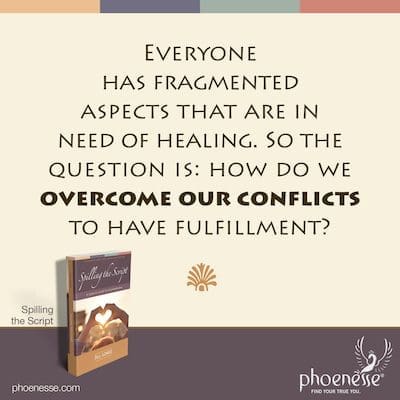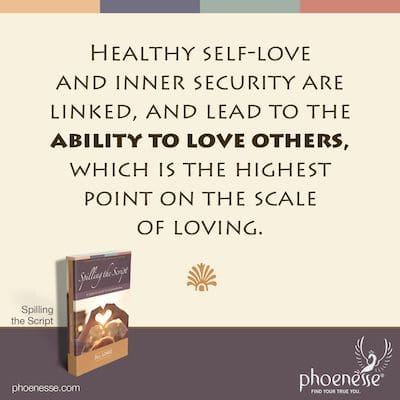
The purpose of creation is connection, or fusion, and to this end, a great irresistible force motivates us toward unification. In fact, fusion with another person happens on four levels: mental, emotional, physical and spiritual.
If we are unified and without inner conflicts, our relationship experiences will be fulfilling, joyous, nourishing and sustaining, adding creative power to the universal reservoir. But in reality, everyone has fragmented aspects that are in need of healing. So the question is: how do we overcome our conflicts to have this?
For infants, closeness is passive—babies only receive. This is as it should be. But for adults, closeness must be mutual with a giving and receiving by both partners. Too often though, our distortions create hard inner walls so that energy cannot flow; we cannot give and we cannot receive. When we’re blocked, there is no fusion and no pleasure, only perpetual frustration.
On the mental thinking level, then, we must learn to express ourselves, even when this is difficult. Not doing so is dishonest and is due to fear of unpleasantness and an unwillingness to risk exposure and confrontation. In short, we won’t do the hard work of going to a more profound level.

What we discover is that we can only communicate in a healthy way—and without guilt—by eliminating our own cruelty; we must release any hidden motive to hurt the other. The energy of our inner tyrant needs to be converted to positive aggression so we can take care of ourselves and set healthy boundaries. Then, when our cruelty is gone and are we no longer stuck in blame, we can speak up.
- If we can’t exchange honestly without cruelty, where is the fear in us?
- What cruelty in us makes us afraid to say what we see?
- Where is our blindness that makes us unsure, defensive and hostile?
A loving connection on the emotional level is expressed by perceiving the complexities and potential of the other. We put aside our ego needs and expectations and make ourselves empty so we can receive the expressions of our partner. Our deep, deep yearning is to really know another—to find true belonging through two people revealing themselves to each other. The Guide tells us that a lifetime would not be enough time to fully know another soul.
We also have a wish for a close physical connection that is in harmony. But if attraction on this level is only for procreation or pleasure, it will not embody this fuller connection, so it will be superficial and disappointing.
To enjoy the full wonders of a spiritual connection then, we must attend to whatever arises in our relationships, becoming willing to risk being vulnerable, and exposing and confronting whatever calls our attention. This is the doorway we must go through if we want to experience bliss. The Pull: Relationships and their Spiritual Significance explores this topic more deeply.

The Guide calls relationships a “path within a path.” This is because our ability to be in a loving relationship depends on our ability to give and receive, which depends on our ability to perceive reality, which depends on our ability to be undefended, which depends on our ability to suffer pain and frustration free from manipulative interpretations. So to be in a relationship is to have our spiritual work laid out in front of us.
For fusion, we must give what we long to receive, including: tenderness, trust, respect, patience, and recognition of another’s capacity for growth; we must offer the other the benefit of the doubt, allowing room for alternative interpretations and letting them unfold their inner essence. When we can let others be who they are, we have the freedom to be our real selves. These are all aspects of mature love.
Images are not really the cause of problems in relationship, the Lower Self is. It uses our mistaken beliefs to hold us in patterns that cause us to stay locked in negative intentionality that says, “I don’t really want to give myself to this relationship.”
We take self-responsibility for this when we delve into how we are the ones recreating our childhood hurts. We want to do this with a loving intention toward ourselves, and not from the inner tyrant that drives us like a slave-master toward growth. But we can only dismantle old patterns bit by bit.
Self-knowledge, self-love and security are all prerequisites to love. Of course, there are degrees and it is not an either-or—we grow and develop these as we go. Sometimes we try to overcome our insecurities through outside pursuits, such as doing good deeds for society. But this often belongs under the heading of escape because security cannot be found outside the self. That doesn’t mean one should cease doing good works, but it needs to accompany establishing a center of gravity within.
To the degree insecurity permeates the soul, the capacity for loving is absent. If we are insecure, we cannot trust ourselves. And if we do not trust ourselves, how can we love ourselves? And we need to love ourselves before we can love another. So healthy self-love and inner security are linked, and lead to the ability to love others, which is the highest point on the scale of loving.

Five Stages of Love
1. Love for inanimate objects
This is lowest on the scale. Objects do not oppose. They do not require the complicated mechanism of perceiving the feelings of another. And they do not disapprove or criticize. They demand a minimum of personal sacrifice or consideration. Objects will make no demands.
2. Love for abstract ideas, principles, art and nature, and love for one’s profession
Love for abstract ideas evades personal involvement with the accompanying apparent risks, but at least it moves the mind, soul or spirit in some measure. It may also require some personal contact and confrontation with others of different opinions. Love for ideas and principles is certainly more outgoing than the isolating pursuit of loving mere objects.
3. Love for plants and animals
They require a certain amount of sacrifice and consideration, putting one’s immediate selfish comfort aside. It does not require the risk of rejection, nor taking the trouble of pondering what the other’s needs are, or the effort to establish mutual understanding. To a very minor degree this may apply to keeping and caring for an animal, but certainly not to the degree required in a close relationship with another human being, where one’s senses have to be alert to the other person as well as to oneself.
4. Love for humankind as a whole
This may still relieve a person from intimate personal involvement — the most taxing form of love, and therefore the most fulfilling one. But it does require effort, thought, the willingness to sacrifice, activity, and many other attitudes that are highly constructive. This applies only if such love is followed through in practice, rather than remaining just a theory.
5. Love for individuals in close, intimate relationship
This is highest on the scale, and most constructive. The fact that we often demonstrate love through turbulent behaviors that have nothing to do with genuine love—but indicate immature needs and dependency and often bring disharmony—still furthers development and our capacity for love. A life of turbulent relationships may be infinitely less harmonious than the life of a hermit or a recluse. But we can’t gauge the process of inner growth by apparent outer harmony.
Consider where love for God would fall on this scale. Is it love for abstract ideas and principles? If so, it can be an escape. For if it is healthy and genuine, our love for God manifests through our love for others with whom we are able to communicate and relate. This, in turn, cannot happen unless we overcome our fears and vanities; unless we find and dissolve the obstructions in us that make us unable and unwilling to love.
We need to have the humility to admit the limitations of our understanding of the inconceivable and incomprehensible existence of the Creator of all beings. And then we can turn our attention to the things human beings can learn—namely, to love other human beings.
To love God as an idea does not require practical involvement and the willingness to put one’s egocentric aims below the needs of another person. So it is possible that an avowed non-believer who is willing to work toward a loving connection with another person is in fact closer to loving God than a professed believer who isolates.
During the Fall, as explained in Holy Moly: The Story of Duality, Darkness and a Daring Rescue, our souls split in two. One aspect of this is the division into masculine and feminine halves, but it is never a perfectly clean split. This means a person will be male or female for most lifetimes, but will also experience the other gender for some lifetimes.
Our longing for union comes from this inherent knowing that another more complete way of being is possible. In some cases, we will be able to reunite with our “soul mate” in this lifetime. In other cases, for a variety of reasons—all of which are in keeping with God’s laws and our karma—we may not. When that is the case, we can still be united with another whom we can love.

Both activity and passivity exist in both men and woman but we manifest different aspects. Our work over the course of many incarnations is to focus on the aspect of development that will bring us more into harmony within ourselves.
The woman’s activity should enliven her receptivity, keeping her vibrant and in fluid perpetual movement. Man’s active currents should bring out his passivity, preventing the active current from becoming too aggressive. By rounding and mellowing it, passivity will take the edges off and slow down the abrupt and too-quick motion of an overactive current.
The same holds true of other supposedly male and female aspects. Without the soul qualities of love, kindness and intuition that open the road to understanding, intelligence and reason will not bring constructive results. On the other hand, love, kindness and intuition, if not kindled by discrimination—which is the result of reason and intelligence—can easily be lost in wrong channels and become destructive.
Further, we need to overcome our mass image that love is weakening and dangerous. In this way, we will find the courage to love.
Return to Spilling the Script Contents



